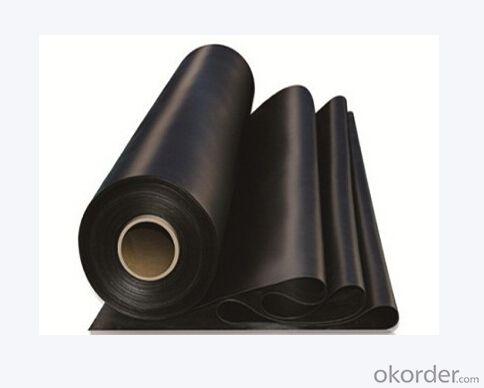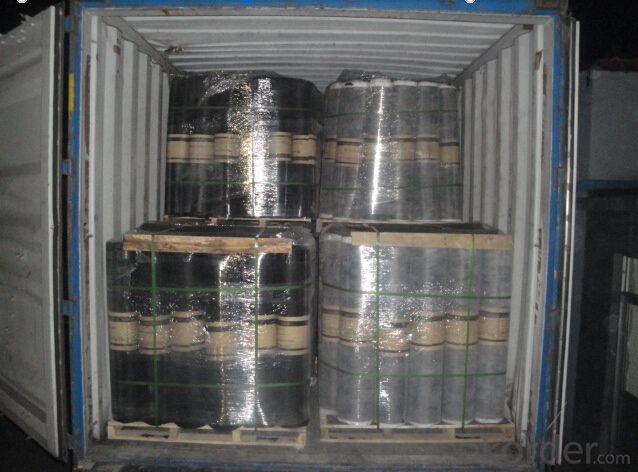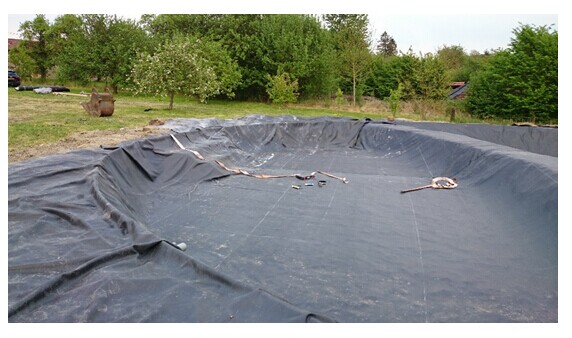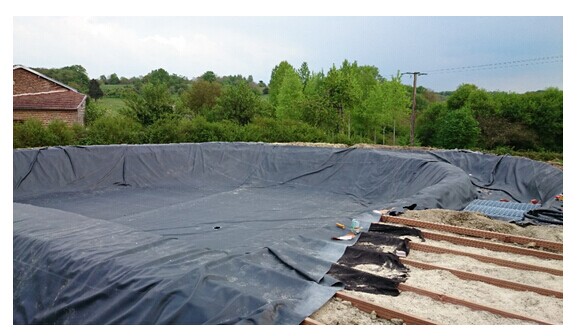EPDM Pond Liner Width 1.2m to 4m Manufacture
- Loading Port:
- Qingdao
- Payment Terms:
- TT OR LC
- Min Order Qty:
- 2000 m²
- Supply Capability:
- 10000 m²/month
OKorder Service Pledge
OKorder Financial Service
You Might Also Like
1.2mm/1.5mm/2mm thick EPDM pond liner/EPDM waterproof membrane
1. Product characteristics
1.Excellent anti-aging performance, service life can reach 50 years;
2.High elongation, high tensile strength, heat treatment size change small;
3.Plant root penetration resistance is good
4.Good low temperature flexibility
5.Application is convenient, overlapping is firm and reliable, no environmental pollution;
6. Resistance to chemical corrosion, can be applied to special places;
7.Maintenance is convenient, the cost is low
2. Uses:
Widely used in roofs, basement, toilet ,swimming pool, and all kinds of industry and civil building waterproofing, reservoir, vivicism, bridge, underground, tunnel and dam waterproofing ,especially to the keystone waterproofing projects which is durability, high corrosion resistance and easy deformation
3. Size:
Item | Thick(mm) | Width | Length(m) | Color |
Spe | 1.0—2.0 | 1.2m/2m/3m/4m | 20 | Black |
Deviation | -1 +15 | --1 | Multicolor |
4. Technical Data:
ITEM | STANDARO REQUEST | |
Tensile strength at breaking,normal temperature,Mpa | ≥7.5 | |
Elongation at breaking, % | ≥450 | |
Tearing strenght,KN/m | ≥25 | |
Bending at low temperature | ≤-40°C | |
Water impermeability,0.1Mpa×30min | Impermeability | |
Hot air aging 80°C×168h | Unchanging of tensile strength at breaking,% | ≥80 |
Unchanging of elongation at breaking,% | ≥70 | |
Appearance of 100% elongation | No crack | |
Property of anti alkali 10% Ca(OH)2×168h normal temperature | ≥80 | |
≥80 | ||
5. Some photos:




- Q:Can a waterproofing membrane be used for a commercial building roof?
- Yes, a waterproofing membrane can be used for a commercial building roof. Waterproofing membranes are commonly used in commercial roofing systems to provide a durable and effective barrier against water penetration. These membranes are designed to withstand the challenges of commercial buildings, such as exposure to the elements, foot traffic, and mechanical equipment. They offer excellent protection against leaks, moisture damage, and other potential roofing issues, making them a suitable choice for commercial applications.
- Q:Does a waterproofing membrane have any impact on the appearance of a surface?
- Yes, a waterproofing membrane can have an impact on the appearance of a surface. Depending on the type and application method of the membrane, it may add a layer of protection that alters the texture, sheen, or color of the surface. Additionally, some membranes may be visible or create a slightly raised or textured effect on the surface. However, there are also transparent or thin membranes available that have minimal impact on the appearance of the surface.
- Q:Can a waterproofing membrane be used for parking structures or garages?
- Parking structures or garages can benefit from the use of a waterproofing membrane. Due to their exposure to harsh weather conditions, these structures are susceptible to water damage. To counter this, a waterproofing membrane acts as a protective barrier, preventing water from seeping into the concrete or other materials. By doing so, it effectively prevents issues like corrosion, cracking, and deterioration. Moreover, it also offers protection against elements such as chemicals, oils, and salts commonly found in parking areas. Therefore, it is highly advisable to incorporate a waterproofing membrane to enhance the longevity and durability of parking structures and garages.
- Q:How thick should a waterproofing membrane be applied?
- The application of a waterproofing membrane is dependent on several factors, including the type of membrane, its intended use, and the project's specific requirements. Typically, the thickness of a waterproofing membrane can vary between 1 and 2 millimeters. When using liquid-applied membranes, it is advisable to apply multiple coats in order to achieve the desired thickness. The number of coats and the thickness per coat will be determined by the manufacturer's instructions and the specific needs of the application. For sheet membranes, the thickness is generally predetermined by the manufacturer and is available in various options, ranging from 0.5 to 2 millimeters. The selection of the appropriate thickness should be based on the project's specific needs, taking into account factors such as the condition of the substrate, expected movement, and required level of protection. In certain instances, local building codes and regulations may also dictate the thickness of the waterproofing membrane. To determine the suitable thickness for a particular application, it is important to consult with a professional waterproofing contractor or refer to the guidelines provided by the manufacturer.
- Q:Can a waterproofing membrane be applied in cold weather?
- Yes, a waterproofing membrane can be applied in cold weather. However, it's important to consider the specific product's instructions and limitations, as some membranes may have temperature requirements for proper installation. Additionally, cold weather conditions may affect the curing time of the membrane, so it's crucial to follow the manufacturer's guidelines to ensure a successful application.
- Q:Are waterproofing membranes resistant to mold and mildew?
- Waterproofing membranes exhibit resistance to mold and mildew in general. Their purpose is to establish a barrier against moisture, halting its infiltration into the structure and thwarting the growth of mold and mildew. These membranes are commonly crafted from materials like rubber, PVC, or bitumen, which do not foster the development of mold and mildew. Moreover, they are installed in a manner that guarantees effective drainage and ventilation, further diminishing the likelihood of mold and mildew formation. However, it is crucial to bear in mind that although waterproofing membranes significantly decrease the risk of mold and mildew, they are not infallible. It remains imperative to maintain adequate ventilation and promptly address any water leaks or damage to prevent the growth of mold and mildew.
- Q:Can waterproofing membranes be used on elevator shafts?
- Yes, waterproofing membranes can be used on elevator shafts. Elevator shafts are often subject to moisture, especially in areas with high humidity or underground installations. Waterproofing membranes are designed to provide a protective barrier against water and moisture, preventing them from seeping into the elevator shaft and causing damage to the structural components or electrical systems. These membranes are typically applied to the walls and floors of the shaft, creating a watertight seal that keeps the interior dry. Additionally, waterproofing membranes can also help to prevent the growth of mold and mildew, ensuring a safe and healthy environment for elevator passengers and maintenance personnel.
- Q:Are there any specific fire safety considerations for using a waterproofing membrane?
- Yes, there are specific fire safety considerations for using a waterproofing membrane. While waterproofing membranes are designed to prevent water penetration and protect structures from moisture-related issues, they may also present fire safety challenges. Firstly, it is important to consider the fire resistance rating of the waterproofing membrane. Building codes and regulations often require certain fire resistance ratings for different building elements, including roofing and wall systems. Therefore, the fire resistance rating of the waterproofing membrane should be evaluated to ensure compliance with these requirements. Additionally, the installation process of a waterproofing membrane involves the use of adhesives, sealants, and other materials that may be flammable. It is crucial to choose fire-resistant materials and ensure proper installation techniques to minimize the risk of fire hazards. Furthermore, the presence of a waterproofing membrane can affect the fire spread and smoke movement within a structure. It is essential to consider the potential impact on fire compartmentalization, evacuation routes, and the overall fire safety strategy of a building. This may involve implementing additional fire protection measures, such as fire barriers, smoke management systems, or fire-rated enclosures, to compensate for the presence of the waterproofing membrane. Regular inspections and maintenance of the waterproofing membrane are also vital. Over time, the membrane may degrade, crack, or become damaged, compromising its fire-resistant properties. Therefore, routine inspections and timely repairs or replacements are necessary to maintain the desired fire safety performance. In summary, fire safety considerations for using a waterproofing membrane involve evaluating the fire resistance rating, using fire-resistant materials during installation, assessing the impact on fire spread and smoke movement, and implementing proper maintenance practices. These considerations are crucial to ensure the overall fire safety of a building when utilizing a waterproofing membrane.
- Q:Are there any specific considerations for installing a waterproofing membrane on sloped surfaces?
- Yes, there are specific considerations for installing a waterproofing membrane on sloped surfaces. One important consideration is the slope gradient, as steeper slopes may require additional measures to ensure proper adhesion and prevent water pooling. Another consideration is the type of waterproofing membrane used, as some membranes may be better suited for sloped surfaces to provide adequate drainage and prevent water penetration. Additionally, proper surface preparation and installation techniques are crucial to ensure the membrane is properly applied and can withstand the stresses of a sloped surface.
- Q:Can a waterproofing membrane be used on precast metal surfaces?
- Yes, a waterproofing membrane can be used on precast metal surfaces. Waterproofing membranes are designed to provide a protective layer that prevents water penetration and can be applied to various types of surfaces, including precast metal. These membranes are typically composed of materials such as bitumen, liquid-applied coatings, or synthetic rubber, which create a barrier against water and moisture. By applying a waterproofing membrane to precast metal surfaces, it can help to prevent corrosion, protect against water damage, and enhance the durability and longevity of the metal structure. However, it is important to ensure that the chosen waterproofing membrane is compatible with the specific type of precast metal surface and that proper surface preparation and application techniques are followed to ensure optimal performance.
1. Manufacturer Overview |
|
|---|---|
| Location | |
| Year Established | |
| Annual Output Value | |
| Main Markets | |
| Company Certifications | |
2. Manufacturer Certificates |
|
|---|---|
| a) Certification Name | |
| Range | |
| Reference | |
| Validity Period | |
3. Manufacturer Capability |
|
|---|---|
| a)Trade Capacity | |
| Nearest Port | |
| Export Percentage | |
| No.of Employees in Trade Department | |
| Language Spoken: | |
| b)Factory Information | |
| Factory Size: | |
| No. of Production Lines | |
| Contract Manufacturing | |
| Product Price Range | |
Send your message to us
EPDM Pond Liner Width 1.2m to 4m Manufacture
- Loading Port:
- Qingdao
- Payment Terms:
- TT OR LC
- Min Order Qty:
- 2000 m²
- Supply Capability:
- 10000 m²/month
OKorder Service Pledge
OKorder Financial Service
Similar products
New products
Hot products
Hot Searches
Related keywords




























